C.S. Harris's Blog, page 13
July 17, 2014
WHO BURIES THE DEAD Cover Flat
 If you're not familiar with the expression "cover flat", it's what the industry calls the flat, unbound cover of a paperback but also by extension the paper dust jacket for a hardcover. Sometimes what looks good on a computer screen isn't nearly as effective when you see it in paper, but this time I actually like the real thing even better than the image I was sent. The title and author name are in copper foil, which is much prettier than it looks in the picture. It also made it extraordinarily difficult to photograph without the foil turning white on me.
If you're not familiar with the expression "cover flat", it's what the industry calls the flat, unbound cover of a paperback but also by extension the paper dust jacket for a hardcover. Sometimes what looks good on a computer screen isn't nearly as effective when you see it in paper, but this time I actually like the real thing even better than the image I was sent. The title and author name are in copper foil, which is much prettier than it looks in the picture. It also made it extraordinarily difficult to photograph without the foil turning white on me.I've actually had it a few weeks and posted it on Facebook but forgot to talk about it here. I think this is the first time I've ever received the cover before I was even sent the copyedits. They always print the covers before they print the books, but this is still really early for a book that won't be released until March. Which I know still seems a long time to wait....
Published on July 17, 2014 10:27
July 11, 2014
The Other Thing I've Been Doing This Past Year
 In addition to writing my Sebastian books, I've also spent the last year getting this house ready to sell.
In addition to writing my Sebastian books, I've also spent the last year getting this house ready to sell.This is the old Arts and Crafts-era cottage my mom bought when she moved back to New Orleans after my dad died. My elder daughter lived here while she went to medical school, and when she graduated last spring, we decided to fix it up before we put it on the market. It wasn't in that bad of shape, but it's situated in a part of the city that has become hugely sought after (it's actually SIX FEET above sea level). People buy these lovely old homes, rip off the cedar siding, throw all the lovely trim work and beautiful windows in a dumpster, then blow them up and out into hideous monstrosities. We didn't want that to happen, so we finished redoing the bathrooms, completely renovated the kitchen ("with granite countertops and stainless steel appliances," as the real estate ads all say), repainted it inside and out, had the floors refinished... You get the idea.
 We thought it would take maybe three or four months. It's taken more than a year and just about killed us. But it was on the market less than twenty-four hours and sold to the first person who looked at it--and who loves it just as it is and says she doesn't want to change a thing. Mission accomplished.
We thought it would take maybe three or four months. It's taken more than a year and just about killed us. But it was on the market less than twenty-four hours and sold to the first person who looked at it--and who loves it just as it is and says she doesn't want to change a thing. Mission accomplished.And yet.... This house has been a part of my life for more than twenty years now, with lots of happy memories and laughter tied up in it. I suspect I'm going to shed a tear when the sale actually goes through in a few weeks.
Published on July 11, 2014 09:33
July 8, 2014
The London of Sebastian St. Cyr: Dealing with the Unknown Dead
Sebastian's London didn't have a morgue, but it did have "dead houses" scattered about the city. Intendedly mainly to receive the bodies of drowning victims pulled from the Thames (there were a surprising number of them) or unidentified corpses found in the streets, the dead houses were actually an innovation. Most British towns and cities (even those in hot climes such as colonial Australia) simply sent their bodies to the mortuaries attached to workhouses (necessary because a lot of people died in workhouses), or to the nearest inn; publicans who refused to accept them could be fined, even when the corpses were in such an advanced state of decomposition that they drove away all living--and paying--customers.
 But not Paris. Dating back to at least 1804, the Paris Morgue was quite a clever concept: one centralized, dedicated building for receiving the unidentified dead. No longer were bereaved relatives forced to scour the city, searching the various taverns and work houses for a missing loved one; they could go to one place and look. Of course, so could anyone, which is how the Paris Morgue came to be a tourist attraction. The root word of morgue is actually morguer, to stare. And stare people did.
But not Paris. Dating back to at least 1804, the Paris Morgue was quite a clever concept: one centralized, dedicated building for receiving the unidentified dead. No longer were bereaved relatives forced to scour the city, searching the various taverns and work houses for a missing loved one; they could go to one place and look. Of course, so could anyone, which is how the Paris Morgue came to be a tourist attraction. The root word of morgue is actually morguer, to stare. And stare people did.
 At the Paris Morgue, the naked bodies of the unclaimed dead--many, but not all, suicide victims pulled from the Seine--were put on display behind a glass window, with their clothes hanging nearby. A particularly gruesome corpse, or a very comely young one, could attract literally thousands a day. So great were the crowds that, after the Revolution of 1830, the city constructed a new, grand edifice. The show was open seven days a week from dawn till six o'clock, and it was free. Visitors to Paris were told to be certain not to miss the morgue, located conveniently right behind Notre Dame; it was even featured in guide books. Men, women, and children jostled one another for the opportunity to leer, or gasp, or sigh in pity at the spectacle.
At the Paris Morgue, the naked bodies of the unclaimed dead--many, but not all, suicide victims pulled from the Seine--were put on display behind a glass window, with their clothes hanging nearby. A particularly gruesome corpse, or a very comely young one, could attract literally thousands a day. So great were the crowds that, after the Revolution of 1830, the city constructed a new, grand edifice. The show was open seven days a week from dawn till six o'clock, and it was free. Visitors to Paris were told to be certain not to miss the morgue, located conveniently right behind Notre Dame; it was even featured in guide books. Men, women, and children jostled one another for the opportunity to leer, or gasp, or sigh in pity at the spectacle.
 Despite its popularity, the Morgue did have its critics and eventually, by the late 19th century, the authorities finally stopped displaying the bodies naked. By 1907, public morality had shifted to the extent that one of the longest running public spectacles ended, and the morgue closed its doors. But by then the concept of a centralized repository for the unclaimed dead had spread around the world.
Despite its popularity, the Morgue did have its critics and eventually, by the late 19th century, the authorities finally stopped displaying the bodies naked. By 1907, public morality had shifted to the extent that one of the longest running public spectacles ended, and the morgue closed its doors. But by then the concept of a centralized repository for the unclaimed dead had spread around the world.
 But not Paris. Dating back to at least 1804, the Paris Morgue was quite a clever concept: one centralized, dedicated building for receiving the unidentified dead. No longer were bereaved relatives forced to scour the city, searching the various taverns and work houses for a missing loved one; they could go to one place and look. Of course, so could anyone, which is how the Paris Morgue came to be a tourist attraction. The root word of morgue is actually morguer, to stare. And stare people did.
But not Paris. Dating back to at least 1804, the Paris Morgue was quite a clever concept: one centralized, dedicated building for receiving the unidentified dead. No longer were bereaved relatives forced to scour the city, searching the various taverns and work houses for a missing loved one; they could go to one place and look. Of course, so could anyone, which is how the Paris Morgue came to be a tourist attraction. The root word of morgue is actually morguer, to stare. And stare people did. At the Paris Morgue, the naked bodies of the unclaimed dead--many, but not all, suicide victims pulled from the Seine--were put on display behind a glass window, with their clothes hanging nearby. A particularly gruesome corpse, or a very comely young one, could attract literally thousands a day. So great were the crowds that, after the Revolution of 1830, the city constructed a new, grand edifice. The show was open seven days a week from dawn till six o'clock, and it was free. Visitors to Paris were told to be certain not to miss the morgue, located conveniently right behind Notre Dame; it was even featured in guide books. Men, women, and children jostled one another for the opportunity to leer, or gasp, or sigh in pity at the spectacle.
At the Paris Morgue, the naked bodies of the unclaimed dead--many, but not all, suicide victims pulled from the Seine--were put on display behind a glass window, with their clothes hanging nearby. A particularly gruesome corpse, or a very comely young one, could attract literally thousands a day. So great were the crowds that, after the Revolution of 1830, the city constructed a new, grand edifice. The show was open seven days a week from dawn till six o'clock, and it was free. Visitors to Paris were told to be certain not to miss the morgue, located conveniently right behind Notre Dame; it was even featured in guide books. Men, women, and children jostled one another for the opportunity to leer, or gasp, or sigh in pity at the spectacle. Despite its popularity, the Morgue did have its critics and eventually, by the late 19th century, the authorities finally stopped displaying the bodies naked. By 1907, public morality had shifted to the extent that one of the longest running public spectacles ended, and the morgue closed its doors. But by then the concept of a centralized repository for the unclaimed dead had spread around the world.
Despite its popularity, the Morgue did have its critics and eventually, by the late 19th century, the authorities finally stopped displaying the bodies naked. By 1907, public morality had shifted to the extent that one of the longest running public spectacles ended, and the morgue closed its doors. But by then the concept of a centralized repository for the unclaimed dead had spread around the world.
Published on July 08, 2014 09:09
July 1, 2014
Scout Without Banjo

Several people have asked how Scout is coping now that we've lost her brother, so I thought I'd do an update.
She'd seemed very lethargic in the week or so before Banjo died and actually perked up a bit after he was gone. We realized she must have known he was dying and been depressed because of it. But there's no denying a spark has gone out of her. It isn't just that she's alone now. She was always the timid one and leaned heavily on Banjo for moral support. He was the calm one, the brave one, the one who bathed her face and neck every day and reassured her when things were scary. Now she's lost that, and she's adrift.
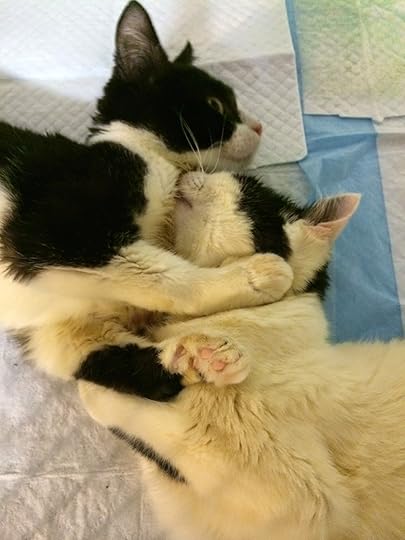
Steve especially spends as much time with her as he can, because she's always been his special girl. But she's not eating well. As much as I miss Banjo, I know she misses him more. He was her rock, and now he's gone.

As for Huck, he seems to be feeling a lot better; he's eating and running around and terrorizing the other cats again. But we are still waiting on some test results.
Published on July 01, 2014 06:53
June 27, 2014
The London of Sebastian St. Cyr: the Ragfairs of Rosemary and Petticoat Lanes
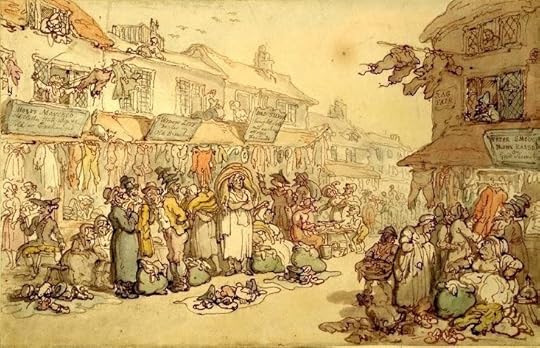 You won't find Rosemary Lane on any modern London map. Running from Dock Street to the Minories near the Tower, it was renamed Royal Mint Street in the nineteenth century. Its famous street market is long gone, too. But for several hundred years, Rosemary Lane was the place to go if you wanted to buy old clothes (as Sebastian sometimes does for his disguises) or if you were on your way down in the world and needed to sell your clothes.
You won't find Rosemary Lane on any modern London map. Running from Dock Street to the Minories near the Tower, it was renamed Royal Mint Street in the nineteenth century. Its famous street market is long gone, too. But for several hundred years, Rosemary Lane was the place to go if you wanted to buy old clothes (as Sebastian sometimes does for his disguises) or if you were on your way down in the world and needed to sell your clothes.Read the accounts of Regency (or Georgian or Victorian) men and women sliding into poverty, and their descent is inevitably marked by visits to old clothes dealers. A nice gown could be exchanged for an not-so-nice gown, with the difference in price going to buy another few days' food and lodging. And when that money was gone, the unfortunate would find themselves back at the old clothes sellers, with the not-so-nice gown being exchanged for something even less respectable--and so on, until one was reduced to the worst imaginable rags. At that point, you starved.
 The shops lining the lane were occupied by old clothes sellers, which is why you see coats and gowns hanging against the sides of buildings. But dealers also sold their goods from stalls or barrows, while some simply spread their piles of old boots and shoes, bonnets, hats, wigs, and stays on the ground or on pieces of old carpet.
The shops lining the lane were occupied by old clothes sellers, which is why you see coats and gowns hanging against the sides of buildings. But dealers also sold their goods from stalls or barrows, while some simply spread their piles of old boots and shoes, bonnets, hats, wigs, and stays on the ground or on pieces of old carpet.Traditionally, many old clothes dealers were Jewish. Look closely at Rowlandson's watercolor above (you can click on it to see a larger image) and you can read the names on the shop signs. Moses Moncera Old Hats and Wigs. Widow Levy Dealer in Old Breeches. You'll also see how many of the dealers are shown wearing long coats and beards (the piles of hats they wear on their heads are a sign of their trade). As a result, most of the stalls and shops were closed on Saturdays until after sundown. The lane did a roaring business on Sunday mornings.
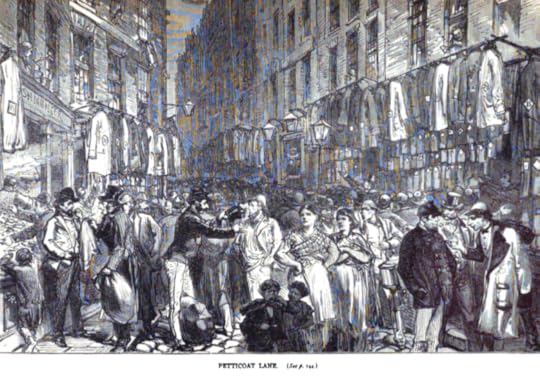 Another street famous for its old clothes trade was Petticoat Lane, shown in the print above. It was actually in a slightly less poor area than Rosemary Lane. In a fit of Victorian prudery, Petticoat Lane was also renamed, becoming Middlesex Street. But its street market still survives--and is still closed on Saturdays.
Another street famous for its old clothes trade was Petticoat Lane, shown in the print above. It was actually in a slightly less poor area than Rosemary Lane. In a fit of Victorian prudery, Petticoat Lane was also renamed, becoming Middlesex Street. But its street market still survives--and is still closed on Saturdays.
Published on June 27, 2014 09:57
June 24, 2014
Restoring Mayberry
 I was researching something recently--whitewash, or lime production, or something weird like that--when I stumbled across this lovely blog.
I was researching something recently--whitewash, or lime production, or something weird like that--when I stumbled across this lovely blog.It's kept by an American who moved to Ireland and blogs about living off the land, and life in Ireland, and doing things the old-fashioned way. He's a wonderful writer and a wonderful photographer, and I now drop in frequently to vicariously savor a place that glows fondly in my memory.

Restoring Mayberry . Worth a visit.
Published on June 24, 2014 08:36
June 20, 2014
Progress
 I've spent the past week organizing my computer files (and I'm still at it!), trying to reconcile my outdated backup with what the Rent-a-Nerd guy managed to salvage. By far the biggest hit was to my iPhotos: out of over 6,000 photos, he managed to salvage just 268. Ouch. So I've been organizing the files from the old backup, looking at old camera cards in the hopes that things like my daughters' graduations last year (med school and MA) are still there, and hitting up family members for their photos.
I've spent the past week organizing my computer files (and I'm still at it!), trying to reconcile my outdated backup with what the Rent-a-Nerd guy managed to salvage. By far the biggest hit was to my iPhotos: out of over 6,000 photos, he managed to salvage just 268. Ouch. So I've been organizing the files from the old backup, looking at old camera cards in the hopes that things like my daughters' graduations last year (med school and MA) are still there, and hitting up family members for their photos.I've made some interesting discoveries along the way, such as the above picture of me with Tracy Grant at Bouchercon in 2010; I misplaced the camera after my trip to San Francisco and found it so long after the fact that I never did anything with the pictures I'd taken. I also found this old scan of me on a dig on San Juan Island in the 70s. I look like a child.
 And I was thrilled to discover this great photograph of my mother at a Mardi Gras parade, age 92, taken just weeks before she died:
And I was thrilled to discover this great photograph of my mother at a Mardi Gras parade, age 92, taken just weeks before she died: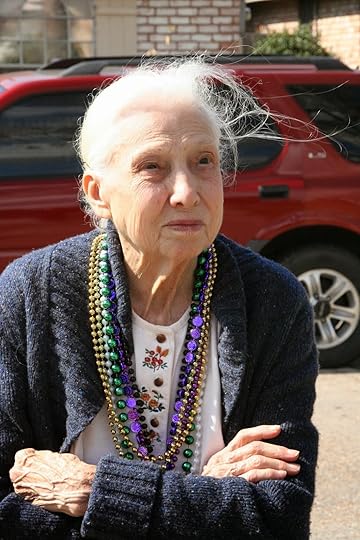 I'm afraid I haven't been spending much time with Sebastian, though, except for three hours while waiting at the orthopedist the other day with a lateral meniscus tear, and the hour I spent at the vet's with Huckleberry. Yes, Huck is not well again. I'm really worried about my baby....
I'm afraid I haven't been spending much time with Sebastian, though, except for three hours while waiting at the orthopedist the other day with a lateral meniscus tear, and the hour I spent at the vet's with Huckleberry. Yes, Huck is not well again. I'm really worried about my baby....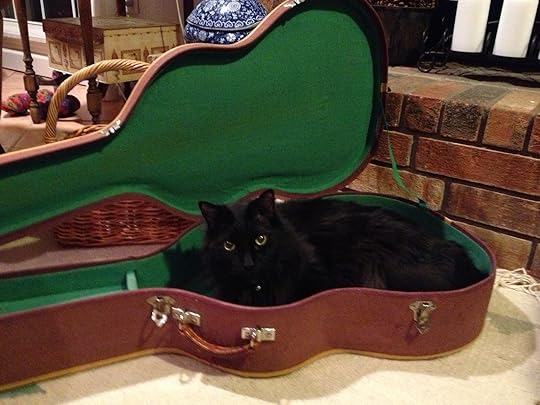
Published on June 20, 2014 08:15
June 16, 2014
And Now for Some (Sorta) Good News
The past five days have been swallowed by the fun (snark) process of setting up a new computer (and a new printer when I realized my old workhorse was no longer supported by anyone) and loading and sorting data from my woefully out-of-date backups.
 I'd been meaning to get a new computer for some time now. But it's always such a hassle that I kept putting it off. Bad idea. Last Wednesday, my old faithful started making funny noises and then (while I was still scrambling around for my external hard drive to back it up as I've been meaning to do forever) went white except for the Dreaded Spinning Ball of Doom.
I'd been meaning to get a new computer for some time now. But it's always such a hassle that I kept putting it off. Bad idea. Last Wednesday, my old faithful started making funny noises and then (while I was still scrambling around for my external hard drive to back it up as I've been meaning to do forever) went white except for the Dreaded Spinning Ball of Doom.
According to the Rent-a-Nerd guy, they were able to recover about 25/26 of my data, although I've yet to load it on my new computer to see exactly what was lost and how it compares to my old backed up files. The good news (and there is some!) is that I do have the first 140 pages of Sebastian Book #11 printed out, so while I may need to retype it if it isn't part of that 25/26, it isn't completely lost.
As you can see from the photo, I now have an external hard drive permanently hooked up and set to back up every hour. I feel like I'm closing the barn door after all the horses are gone, but better late than never, right? I'm also looking into someplace in the Cloud to back up to as well (suggestions are welcome).
The funny thing is, I used to be fairly good about backing up. But somehow in the past year I let it slide--along with everything else. Lesson learned.
Oh, and you can also see my new mouse pad! He doesn't look like my vision of Sebastian, but I do love that cover.
 I'd been meaning to get a new computer for some time now. But it's always such a hassle that I kept putting it off. Bad idea. Last Wednesday, my old faithful started making funny noises and then (while I was still scrambling around for my external hard drive to back it up as I've been meaning to do forever) went white except for the Dreaded Spinning Ball of Doom.
I'd been meaning to get a new computer for some time now. But it's always such a hassle that I kept putting it off. Bad idea. Last Wednesday, my old faithful started making funny noises and then (while I was still scrambling around for my external hard drive to back it up as I've been meaning to do forever) went white except for the Dreaded Spinning Ball of Doom.According to the Rent-a-Nerd guy, they were able to recover about 25/26 of my data, although I've yet to load it on my new computer to see exactly what was lost and how it compares to my old backed up files. The good news (and there is some!) is that I do have the first 140 pages of Sebastian Book #11 printed out, so while I may need to retype it if it isn't part of that 25/26, it isn't completely lost.
As you can see from the photo, I now have an external hard drive permanently hooked up and set to back up every hour. I feel like I'm closing the barn door after all the horses are gone, but better late than never, right? I'm also looking into someplace in the Cloud to back up to as well (suggestions are welcome).
The funny thing is, I used to be fairly good about backing up. But somehow in the past year I let it slide--along with everything else. Lesson learned.
Oh, and you can also see my new mouse pad! He doesn't look like my vision of Sebastian, but I do love that cover.
Published on June 16, 2014 09:08
June 13, 2014
Remembering BC/Baby
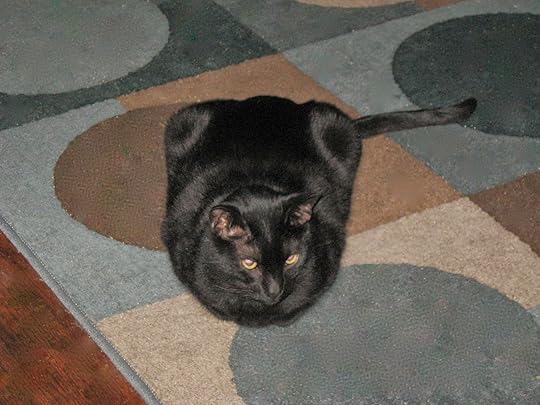 Baby came into our lives more than ten years ago, a stray who showed up on my mother’s porch. We never knew his story, although I’ve always suspected he must have been the companion of some elderly person or child—someone who loved him dearly but had no control over his fate. He was desperate for a new home, desperate for people to love. But neither my mother nor I were in a position to bring him inside, so while I tried to find someone to take him (that’s when I discovered how difficult black cats are to place), she began feeding him. We named him BC, short for “Black Cat.” Not very original, but then we didn’t expect him to be a part of our lives for long. Because he loved pets so much, we’d spend hours out on the porch with him in our laps, while he purred and cuddled and said, “I really, really want to come inside.” He broke our hearts, but with two aggressive alpha male cats, bringing him inside just didn’t seem an option.
Baby came into our lives more than ten years ago, a stray who showed up on my mother’s porch. We never knew his story, although I’ve always suspected he must have been the companion of some elderly person or child—someone who loved him dearly but had no control over his fate. He was desperate for a new home, desperate for people to love. But neither my mother nor I were in a position to bring him inside, so while I tried to find someone to take him (that’s when I discovered how difficult black cats are to place), she began feeding him. We named him BC, short for “Black Cat.” Not very original, but then we didn’t expect him to be a part of our lives for long. Because he loved pets so much, we’d spend hours out on the porch with him in our laps, while he purred and cuddled and said, “I really, really want to come inside.” He broke our hearts, but with two aggressive alpha male cats, bringing him inside just didn’t seem an option.Fast forward to seven years ago. We were leaving my mother’s house one evening when BC came crawling up on the porch. He was in such awful shape, I thought he’d been hit by a car and had a broken leg or back. In truth, he was starved and massively dehydrated. We figured he must have been accidentally shut in a neighbor’s shed and almost died there before he was let out. As it was, he almost died in my arms as I sat up all night holding him and coaxing him to drink and eat. I promised him that if he survived, we’d bring him inside and give him a real forever home.
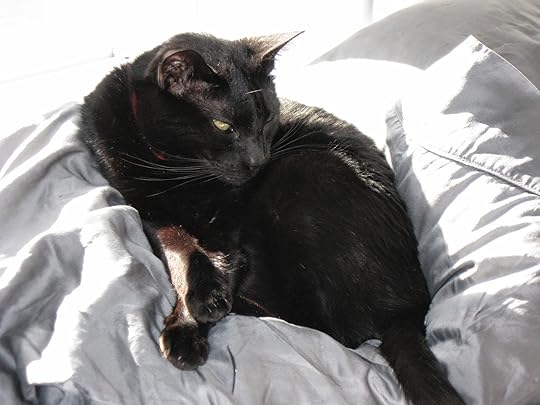
It was my older daughter who took over his rehabilitation; she also renamed him Baby. He was so debilitated, it was months before he could walk without falling over, or jump again. But we came to realize that, in truth, we should have named him Buddha Cat, because he was a very evolved soul—endlessly patient, kind, and loving and giving to both people and the other cats who came into his life. Here he is cuddling our cat Nick when Nick was dying of kidney failure a few years ago…
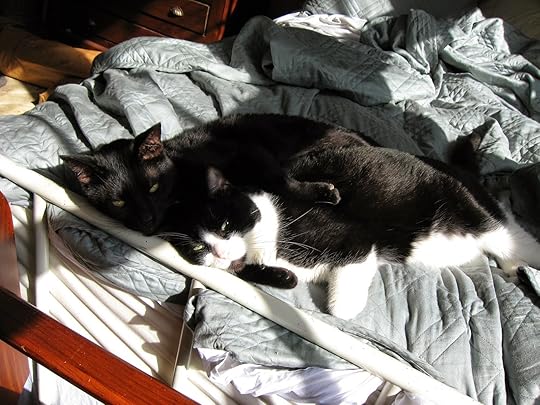
We never knew how old Baby was; the vet who helped us nurse him back to health seven years ago said he was at least ten and probably more. And then, last fall, he started having health problems. We knew it was only a matter of time, but through it all he remained as calm and as loving as ever. And this past Monday, just two days after we lost Banjo, Baby died, held lovingly in my daughter’s arms.
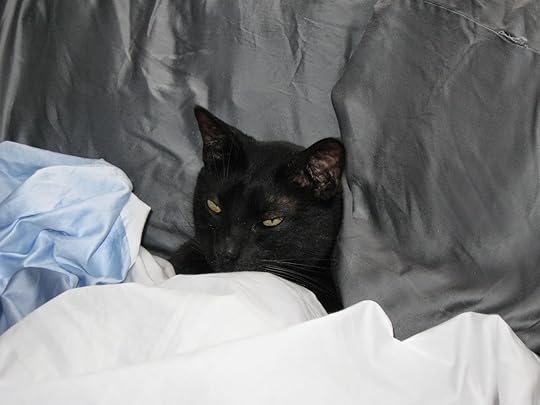
You know, my computer went into meltdown this week, and I’ve never been as good about backing up as I should be. Yet even though the data loss was massive, I am (uncharacteristically!) finding it hard to get too upset about it. Some things really aren’t as important as they might otherwise seem.
Published on June 13, 2014 09:37
June 8, 2014
Saying Goodbye to My Banjo
 We lost Banjo this past weekend. He was only fourteen months old.
We lost Banjo this past weekend. He was only fourteen months old.He came to us on my birthday, in September. A heartbreakingly skinny jumble of skin and bone and dirty fur that weighed barely a pound despite being six months old, he’d been born feral with cerebellar hypoplasia, which made it hard for him to walk or even stand for long without falling over. I didn’t want to take on such a huge responsibility, didn’t want any more cats. But I couldn’t leave him and his sister to die miserable deaths, so we trapped them and brought them home.
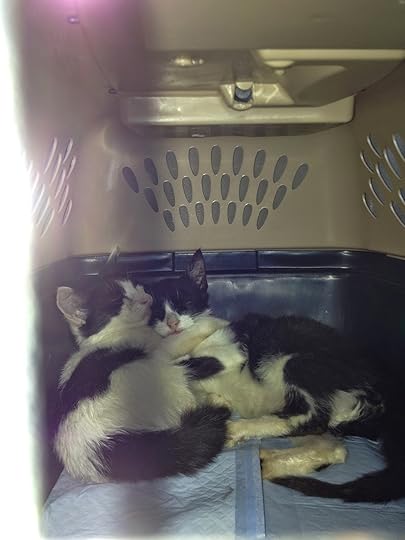 We almost lost them that first week when they had an inexplicable, nearly fatal reaction to their vaccinations. After bottle-feeding them kitten formula around the clock for weeks, we finally had to acknowledge that as bad as they had been before, they were now worse. Scout eventually was able to feed herself and drink unaided (although she’s since lost that ability…), but Banjo never could manage it again. So I hand fed him, three times a day, month after month. The bond we formed was fierce. His coordination might be lousy, but there was never anything wrong with his mind or his heart or his soul. He was an amazing little guy.
We almost lost them that first week when they had an inexplicable, nearly fatal reaction to their vaccinations. After bottle-feeding them kitten formula around the clock for weeks, we finally had to acknowledge that as bad as they had been before, they were now worse. Scout eventually was able to feed herself and drink unaided (although she’s since lost that ability…), but Banjo never could manage it again. So I hand fed him, three times a day, month after month. The bond we formed was fierce. His coordination might be lousy, but there was never anything wrong with his mind or his heart or his soul. He was an amazing little guy.
Through it all he remained as alert, intensely aware, happy-go-lucky, and loving as ever. He brought me endless joy and laughter and love, and he taught me some much needed lessons about patience, and perseverance, and acceptance. Although I didn’t realize it at the time, I was blessed the day Banjo came into my life. And I am devastated now that he has gone out of it.
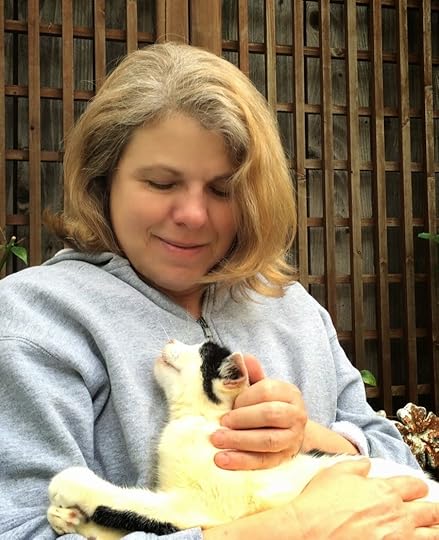
Farewell, my little friend. You are badly missed.
Published on June 08, 2014 21:09



